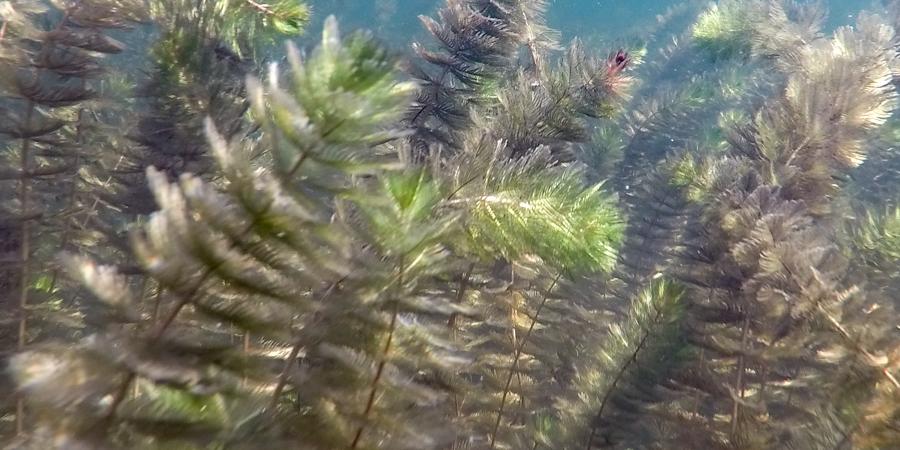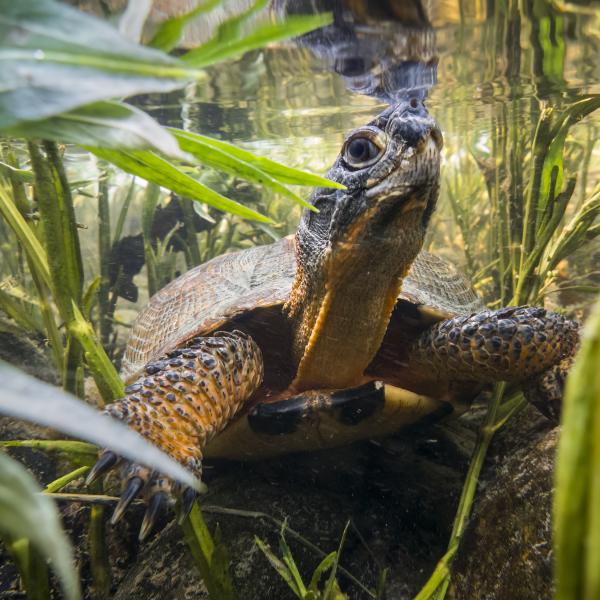AsRA’s River Steward, Liz Kamb, is raising awareness about invasive species among residents of and visitors to the Ausable watershed. These species are non-native to the Adirondack region and harmful to Adirondack ecosystems, causing declines in water quality and competing with native plants and animals. The river steward conducts visual surveys for aquatic invasive species on the Ausable River throughout the summer, but she needs your help in identifying new populations of invasive aquatic plants. With many more eyes on the lookout, concerned citizens can make a big difference in the identification and subsequent eradication of new aquatic invasive plant populations.
First, it’s important to understand the differences between native, non-native, invasive, and nuisance species. Native species are species that were indigenous to a region at the time of European settlement. Non-native species are species that were accidentally or purposefully introduced to an area outside of its historical range. These species might also be referred to as “exotic,” “introduced,” or “alien” species. Invasive species are non-native species with harmful characteristics. They can be generalist species that are capable of colonizing wide ranges of environments, meaning they are tolerant of environments where other plants might not survive. They typically reproduce at a fast rate, sometimes with various methods of reproduction. Invasive plants also lack natural predators, parasites and diseases necessary to limit their population growth, which allows them to monopolize resources such as light and nutrients from other native plants. Finally, and most importantly, invasive species displace native species and cause ecological, economic, or societal harm (a threat to public health for example). Nuisance species, on the other hand, might be species that interfere with human activities (such as gardening), but do not pose a specific threat to local ecosystems, economies, or human communities. For example, dandelions are a common “weed” that many gardeners do not want in their lawns. However, they are ecologically beneficial because they are some of the first sources of sustenance for pollinators in the springtime.
The impacts of invasive species can be diverse and alarming. Next to human-caused habitat destruction, invasive species are the second leading cause of the loss of biodiversity worldwide. Some of the ecological impacts of invasive species include ecosystem simplification via displacement of native species, disruption of food chain dynamics, and loss of biodiversity. Additionally, invasive species can cause economic damage. Dense thickets of aquatic plants can clog drains and other utility infrastructure as well as deter recreational tourism. Who wants to swim, fish, or boat in a river, lake or pond infested with nasty invasive vegetation? Not tourists, and not locals either. Because of this, it’s important that every Adirondack resident and visitor make an effort to become familiar with invasive plant identification tools. If more people are keeping an eye out for invasive species in our local waterways, we have a much better chance of identifying new introductions of invasive plants so they can be quickly eradicated by organizations such as the Adirondack Park Invasive Plant Program (APIPP). When it comes to managing invasive plants, the sooner they are identified the better.
The most important thing in learning to identify invasive plant species is to develop an understanding of the physical characteristics used to identify aquatic plants. Here are five key anatomical features used to identify aquatic plants:
- Where the plant is growing
- Leaf arrangement on stem
- Leaf blade architecture
- Characteristics of the leaf edge
- Venation of the leaf
Let’s dive a little deeper
The general place where the plant is growing might be characterized as emergent, floating, or submerged. Emergent means that the plant grows up and out of the water for the majority of the growing season. Emergent plants might have a thick, waxy cuticle to prevent the leaves from drying out. Leaves and stems are also rigid and composed of spongy tissue and air spaces to keep them above the water.

Emergent, floating, and submerged aquatic vegetation groups.
Floating leaf plants will have leaves at the surface of the water, either attached or unattached to the substrate below. Stems attached to the substrate will be elastic, or have lots of slack. Floating leaf plants might also be tough and leathery due to their waxy cuticle. Additionally, they are usually circular or elliptical leaves with smooth margins.

Examples of attached and unattached floating aquatic plants including Duck weed (left) and Water shield (right).
Submersed plants create the majority of biomass below the water surface. They do not usually have a thick cuticle because they are always below the water surface so there is no need to protect from drying out. Therefore, leaves tend to be flexible so they can float in the water column without resisting water movement.
Leaf arrangement can be categorized as alternate, opposite, or whorled. Alternate arrangement is when one leaf grows from each node, with leaves emerging in an alternating fashion as you go up the stem. Opposite arrangement is when two leaves emerge from each node, on opposite sides of the stem. Whorled arrangement occurs when three or more leaves arise from each node, emerging from many directions around the stem.

Examples of alternate (left), opposite (middle), and whorled (right) leaf arrangements.
The leaf blade architecture is characterized as either simple or compound. Simple leaves have an undivided blade whereas compound leaves have a fragmented blade with many leaflets.

Unlike a simple leaf blade, a compound leaf blade is divided into several leaflets.
The edge of the leaf blade might be entire, sinuate, dentate, or lobed. Entire meaning that the leaf has a smooth margin and sinuate meaning that the leaf has small curves and wavy edges. A dentate leaf has little teeth on the edges of the leaf, and a lobed leaf is one that is partially divided.

Sinuate (left), dentate (middle), and lobed (right) leaf examples.
The venation of the leaf is another characteristic that can help to identify an aquatic plant. This attribute can be characterized as parallel, palmate, or pinnate. Parallel veins will run parallel to each other (as the name suggests) from the base to the apex of the leaf. Palmate venation occurs when all veins emerge from a central point and radiate out. Pinnate venation is when veins are arranged along two sides of a central midvein.

Parallel (a), pinnate (b), and palmate (c) leaf venation.
Let’s go through an example
Eurasian watermilfoil is a common invasive plant found in New York State. This aquatic invasive plant is easily confused with other native and non-native species of milfoil. However, there are a few specific characteristics that set it apart from the rest. Look at the photos below as you follow along in this identification. Eurasian watermilfoil is a submerged plant with compound leaves that are deeply divided. You will see that the leaves are in a whorled arrangement about the plant stem with four leaves per whorl, whereas many other species of milfoil only have three. However, hybrid species can be difficult because they can display either or both characteristics. The shape of Eurasian watermilfoil’s leaf is quite specific, with the apex of the leaflet being flat as though someone snipped off the end with scissors. This is another characteristic that sets Eurasian watermilfoil apart from other milfoils. Close to reproduction, the plant will also grow an emergent spike with both male and female flowers. This extension is above the water surface and has a red tip where there is new growth.

Eurasian watermilfoil diagram and floating examples, highlighting emerged reproductive stem and four whorled, "cut off" leaves.
This is just one of the many invasive aquatic plants that could be present in Adirondack rivers, lakes and ponds. We are lucky that the Ausable River has (so far) remained free of aquatic invasive plants. However, the Ausable River is also at risk of introduced invasive species since many of the larger lakes in the region are infested, such as Lake Champlain and Lake George. As you enjoy your time on the Ausable River this summer, protect it from aquatic invasive species by washing your gear before and after entering the water. You can also use your new aquatic plant identification tools to help AsRA keep an eye out for pesky and potentially disastrous aquatic invasive plant species.
Content reference: Corey Laxson, Senior Research Associate, Paul Smith’s College Adirondack Watershed Institute
Photo references:
Where it grows: https://fw.ky.gov/Fish/Pages/Farm-Pond-Management-Vegetation-Control.aspx
Floating unattached: https://fw.ky.gov/Fish/Pages/FPM_Veg_NRF.aspx
Floating attached: https://nature.mdc.mo.gov/discover-nature/field-guide/water-shield
Alternate arrangement: Adapted from Christian Fischer photo, Creative Commons
Opposite arrangement: Adapted from Leslie J. Mehrhoff photo, University of Connecticut, Creative Commons
Whorled arrangement: Adapted from Robert Videki photo, APIPP website: adkinvasives.org
Blade architecture: https://www.uwgb.edu/biodiversity/herbarium/trees/simple_compound_leaves01.htm
Sinuate: https://nas.er.usgs.gov/queries/FactSheet.aspx?speciesID=1134
Dentate: https://nas.er.usgs.gov/queries/FactSheet.aspx?speciesID=263
Lobed: https://snohomishcountywa.gov/DocumentCenter/View/63042/Floating-Leaved-Aquatic-Plant-ID-Guide
Venation: https://courses.lumenlearning.com/boundless-biology/chapter/leaves/
Eurasian Watermilfoil top right: Adapted from Daniel George photo, "Invasive Species Management: Lake Minnetonka’s Problem With Eurasian Watermilfoil"
Eurasian Watermilfoil Diagram: https://nas.er.usgs.gov/queries/greatlakes/FactSheet.aspx?SpeciesID=237&Potential=N&Type=0
Eurasian Watermilfoil bottom right: https://nas.er.usgs.gov/queries/FactSheet.aspx?speciesID=237



